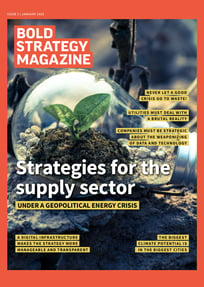The biggest climate change potential is in the biggest cities
.png)
Today, around 55% of the world's population lives in cities. Most of the world's economy is also located in cities, as is the share of world energy consumption and greenhouse gas emissions. So, according to David Miller, it is also in cities that solutions must be found. He is leading the C40 cities whose mayors are coming together to show leadership in the fight against climate change.
David Miller, former two-time mayor of Toronto, provided valuable insight into green strategies during a geopolitical energy crisis when he spoke at the Utilities Conference. Miller is at the forefront of the fight for sustainability as executive director of the C40 Centre for Urban Climate Policy & Economy - a global coalition of 100 major cities focused on meeting the Paris Convention to reduce global warming.
Speaking to conference participants from his home city of Toronto on the key issue of tackling the energy crisis, he began with a simple and clear recommendation: 'What we need to do is dramatically and rapidly reduce our dependence on energy from fossil fuels'.
It may sound ambitious, but David Miller is genuinely optimistic: "We can do it because of the leadership shown by cities." He points to what cities are doing, citing recent research by C40 on natural gas. "I think it's an extraordinarily important issue because gas is seen by some as a transition fuel, but it's simply not. It's about as polluting as coal if you include methane leaks in the system," he says.
Climate change is seen in countries all over the world
As head of the C40, where cities like London, Paris, Jakarta, Beijing, Shanghai, São Paulo, and Copenhagen work together, he is more aware than most of the serious climate crisis the world is facing. Although the latest science shows we are nowhere near keeping the average temperature rise to 1.5 degrees, Miller says it is still possible to reach this crucial goal. But it must be done quickly.
"For that to happen, global emissions in 2030 need to be on track for net zero by 2050. Because of what's happening in the Arctic and elsewhere, more and more methane is being released into the atmosphere. We are already seeing the results: devastating floods in Pakistan and terrible events in many other places. In Canada, we have heat waves in the rainforest and then floods of biblical proportions literally in the same place," he says.
"A town called Lytton in British Columbia burned down in 15 minutes during a heat wave. So, it's not just places like Pakistan that we're seeing the effects of climate change, but in countries all over the world. It's serious and, as I said, we're nowhere near being able to stay below 1.5 degrees," points out David Miller.
The war in Ukraine doubles the problem
To further underline the seriousness of the issue, David Miller points out that every 0.1 degree by which we fall short of the global target has exponentially serious consequences. And as for the current energy crisis, Miller blames Russia and its "illegal and immoral invasion of Ukraine".
With the twin issues of Russia's war and its impact on energy supply and costs, and a climate crisis that requires us to use far less energy, it is time to implement strategies to move rapidly away from fossil fuels - a point on which Miller is supported by the International Energy Agency. So how can the world's big cities and their leaders make a difference and help bring about a tipping point?
"C40 is a great organization of mayors of the world's largest cities," explains David Miller. "They influence through their actions and use their influence as representatives of well over 700 million people in cities that make up around 25% of the world's economy. They are important spokespeople because the world today is an urban world and that's a fairly new phenomenon. From the dawn of human civilization until just over a decade ago, the world was predominantly rural. But from here and into the foreseeable future, our planet is becoming increasingly urban."
It's in cities that the solutions lie
Urbanization is driven by migration to urban areas across the globe - particularly to megacities in China, Africa, and Latin America, where around 55% of the world's population now lives. The majority of the world's economy is also located in cities, as is the share of world energy consumption and greenhouse gas emissions. In developing countries, cities are constantly developing and expanding, while areas facing serious problems of rising sea levels, floods, droughts, and other forms of climate change are left behind.
"It is in cities that most of the underlying problem exists. The world's big cities house most of the economy, population, energy use and emissions. But as a result, the solutions are also in the cities," says David Miller.
"It is obvious to target efforts at the places where the problems are greatest. The good news is that these C40 mayors are coming together and showing leadership in the fight against climate change. I've written a book about it called 'Solved'. The basic thesis of 'Solved' is that because most of the greenhouse gases the world emits either come directly from cities or from the activities needed to sustain them, such as power plants, this is also where we should be looking for solutions."
70% of emissions come from four main sources
According to his book, the immediate efforts and prospects are not all bleak. There are also bright spots from Miller's perspective. One of them is that about 70% of greenhouse gas emissions in cities or from the activities needed to run them come mainly from four main sources; namely transport, buildings, electricity use, and waste management. This is also true globally, which means that there is a huge potential for targeted action in a relatively small number of areas.
"The distribution and potential depend on the type of city. In a densely populated city with good public transport links like New York, most emissions, probably around 70%, come from buildings. In an African city like Accra, the biggest problem is waste management and an informal system of waste dumps that generate huge amounts of methane. If it wasn't for that, Accra would have quite low emissions per capita, so the city can really focus its efforts," says David Miller.
Understanding the Impact of Climate Change
As a former two-time Mayor of Toronto, David Miller is perfectly placed to know understand the impact of large urban areas on climate change. But he is also fully versed in the ways that cities can be at the forefront of solutions to this global problem. In Part 2, Miller tells us why we still have reasons for optimism and that we can look to great leadership in major cities.
In November 2022, a conference on how the energy crisis and utility strategies are now one of the biggest challenges for all companies, was held at the Danish Parliament. To get all valuable insights from this conference, feel free to download the Magazine with everything that you need.



.png?width=596&name=Climate%20Crisis%20(1).png)






.png?width=80&name=USED%20(1).png)